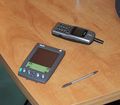This week I was in Malta for a couple of days and as usual I was looking for some affordable local tariffs for wireless Internet access with one of the 3G operators on the island.
Offers from both Vodafone and Go Mobile sounded promising and reception in the hotel room was equally good so I let chance decide which one to take. Vodafone SIMs were sold out in two tourist shops I tried but I was able to get a Go Mobile SIM card with the second one. No registration, they are just sold over the counter for 10 euros and an extra 10 euros for some credit to activate their internet offer for 4 euros for 10 days, 350 MB max. This should do for the vacation. So far so good. Activation of the SIM card was straight forward by just calling a short code and activation of the Internet offer was done quickly as well by sending an SMS with the name of the offer which was confirmed within the minute. What didn't quite work as expected was that the line was not provisioned for packet access, i.e. the GPRS attach was always rejected. Strange, you can book an Internet offer but GPRS services are not activated at the same time?
So I first called the customer help and top-up line (123), or at least tried to, as whenever I pressed the option in the voice based menu for a customer representative the call was released. Real good customer service… After the third time I gave the leaflet that came with the SIM card a closer look and found another direct number for the customer help line. Fortunately there was an English help-desk so I explained the issue without getting too technical. The support person insisted to send me an SMS to configure my phone despite me explaining several times that it's not the phone but the network that needs to be configured. I gave up in the end hoping that the SMS configuration would perhaps also trigger the corresponding network parameters for my line to be set up. Unfortunately it didn't. I was almost prepared to give up and search for a Vodafone SIM but wasting 20 Euros is a bit much. So I decided to give them a final call. I ended up with the same support person as earlier, explained to him the issue again and this time gave him the full technical issue –> "Configure my line in the HLR for GPRS services". I was put on hold for a couple of minutes so I guess he spoke to a network technician. When he came back he told me that things should be working now so I restarted the phone and indeed, the GPRS attach went through this time.
Fine, I had Internet access now but this raised a number of questions:
- Why were packet services not activated in the first place?
- Why weren't they activated when I bought the Internet bundle via SMS?
- Why was the call to the help line not working via the general number?
- Why did it take two calls to get things working despite a precise error description?
Without technical background knowledge I don't think I would have gotten it to work. Also I was quite glad I had a Symbian phone with me because here one can see on the idle screen why things weren't working (the GPRS attach already failed). On other devices based on Android, for example, this information can't be seen at all.
So, Go Mobile, if you read this, have a look at your back-end procedures to see how they can be streamlined to make things a bit smoother. Oh and yes, by the way, make the default APN work so people don't have to guess the APN for general Internet access after the GPRS attach works (which is 'rtgsurfing' by the way).

